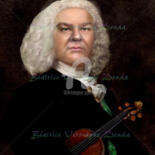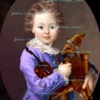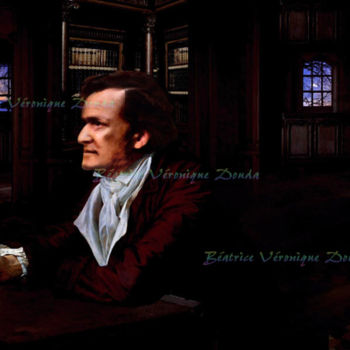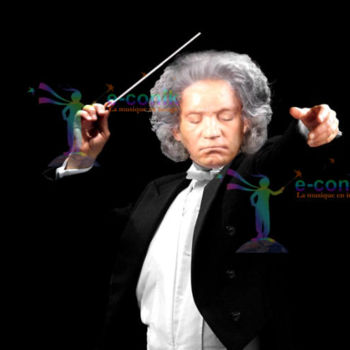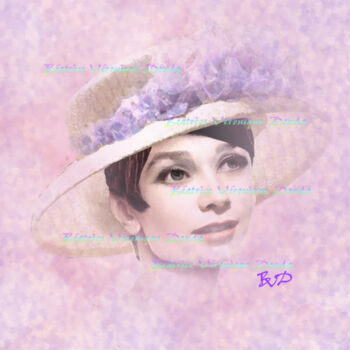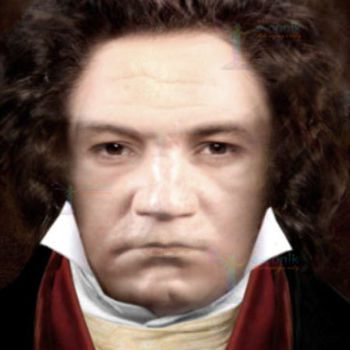


Lassen Sie uns wissen, wenn Sie mehr Fotos von diesem Kunstwerk sehen möchten!
- Rückseite der Arbeit / Seite der Arbeit
- Einzelheiten / Unterschrift / Oberfläche oder Textur des Kunstwerks
- Kunstwerk in Situation, Andere...
Jean Sébastien Bach Leipzig 1739 (2020) Digitale Kunst von Béatrice Véronique Douda
Mehr Infos
- Verpackung (Schachtel oder Kartonverpackung) Alle Kunstwerke werden mit einem Premium-Carrier geliefert, sorgfältig geschützt und versichert.
- Kundendienst Auftragsverfolgung bis zur Zustellung des Pakets an den Käufer. Eine Tracking Nummer wird zur Verfügung gestellt, damit Sie das Paket in Echtzeit verfolgen können.
- Fristen Weltweite Lieferung in 3 bis 7 Tagen (Schätzen)
- Zoll nicht inbegriffen Der Preis beinhaltet keine Zollgebühren. Die meisten Länder haben keine Einfuhrsteuer für Originalkunstwerke, aber Sie müssen möglicherweise die reduzierte Mehrwertsteuer zahlen. Zollgebühren (sofern anfallend) sind bei der Ankunft vom Zollamt zu berechnen und werden vom Spediteur separat in Rechnung gestellt.
Mehr Infos
- Verfolgbares Online-Echtheitszertifikat Echtheitszertifikate können jederzeit online überprüft werden, indem der Code des Kunstwerks gescannt wird.
- Künstlerwert-Zertifizierung Experten untersuchen das Werk und den Werdegang eines Künstlers und ermitteln dann einen unabhängigen und zuverlässigen Durchschnittspreis. Der durchschnittliche Preiswert ordnet den Künstler in einer Preisspanne für einen bestimmten Zeitraum ein. Die Sachverständigen können auch gebeten werden, einen genaueren Schätzwert für ein bestimmtes Werk zu ermitteln.
Mehr Infos
100% sichere Zahlung mit SSL-Zertifikat + 3D Secure.
Mehr Infos
-
Original-Kunstwerk (One Of A Kind)
Digitale Kunst,
Digitale Malerei
auf Leinwand
- Masse Höhe 23,2in, Breite 18,1in
- Rahmen Dieses Kunstwerk ist nicht gerahmt
- Kategorien Digitale Kunst unter 5.000 $ Figurative Musiker
A cette époque, il est compositeur de la Chapelle royale de la cour de Saxe. Son œuvre magistrale, essentiellement dédié à Dieu, s’enrichit à cette époque-là, de grandes œuvres sacrées. Bach ne recherche ni la reconnaissance ni la gloire humaine. Sa plume est au service du sacré. Ainsi, en 1723, il donne naissance à un Magnificat, en 1724, La Passion selon Saint Jean voit le jour et en 1727, la Passion selon Saint Matthieu dévoile, une fois de plus l’âme mystique du compositeur.
Jean Sébastien Bach ou l’art de nous transmettre les hauteurs invisibles tendues vers l’âme. L’art aussi de peindre un possible espoir, une trouée de lumière aux yeux de notre condition humaine. La puissance de la composition musicale s’érige en arcs vibratoires de cristaux étincelants à la gloire de Dieu, ce Créateur que le compositeur n’a de cesse de louer pour ses grandeurs et ses beautés, ses largesses et ses bontés.
Et l’éphémère humain se trouve aspiré dans le souffle créateur, tourbillon d’amour éternel. Les mots disparaissent, les corps s’éthérisent, l’âme est élevée au-dessus d’elle-même. Le Mystère se révèle, l’éblouissement est total, la créature réconciliée.
Jean Sébastien Bach, l’art de composer avec l’encre du souffle de Dieu ? Avec sa collaboration ? Sa bénédiction ? Confions-nous à la musique, sa musique. Elle seule recèle des réponses cachés mais qui balbutient ses secrets à l’âme qui se laisse pétrir de beauté.
La musique de Jean Sébastien Bach est une architecture qui le précède. Et le compositeur de construire, d’agencer, d’ordonner l’invisible harmonie. Non pour lui. Pour Dieu seulement.
Les ans passent, les partitions s’amoncèlent, les œuvres se succèdent.
1739. Jean Sébastien Bach est en marche vers ce qui le dépasse, un langage de vie qui trame son être, le chant de Dieu. Son dernier souffle frappe à la porte de sa poitrine, attend de s’échapper de sa cage. 1750. Jean Sébastien Bach s’en est allé. Là-bas, se fondre dans la blancheur de la partition divine : celle de l’éternel amour créateur.
« Que m’importe les heures, que m’importe les siècles !
Ton Harmonie Ô Dieu est, de mes os, la chair.
Je ne vois que Ta Face, sa puissante lumière.
Les hommes m’oublieront, Toi, tu me porteras.
De cantates en prières, je me dissous en Toi.
Que m’importe la Terre, l’Eternité c’est Toi. »
SDG
Jean Sébastien BACH, Leipzig, 1739.
At that time, he was composer of the Royal Chapel of the court of Saxony. His masterful work, essentially dedicated to God, was enriched at that time by great sacred works. Bach does not seek recognition or human glory. His pen is at the service of the sacred. Thus, in 1723, he gave birth to a Magnificat, in 1724, The Passion according to Saint John was born and in 1727, the Passion according to Saint Matthew, once again unveils the mystical soul of the composer.
Jean Sébastien Bach or the art of transmitting to us the invisible heights stretched out towards the soul. The art also of painting a possible hope, a gap of light in the eyes of our human condition. The power of musical composition arises in vibrating arcs of sparkling crystals to the glory of God, this Creator whom the composer never ceases to praise for his grandeur and his beauties, his generosity and his bounties.
And the human ephemeral finds itself sucked into the creative breath, a whirlwind of eternal love. Words disappear, bodies etherize, the soul is raised above itself. The Mystery is revealed, the dazzling is total, the creature reconciled.
Johann Sebastian Bach, the art of composing with the ink of the breath of God? With his collaboration? His blessing? Let us confide in the music, its music. It alone conceals hidden answers but which stammer its secrets to the soul which allows itself to be kneaded with beauty.
The music of Johann Sebastian Bach is an architecture that precedes it. And the composer to construct, to arrange, to order the invisible harmony. No for him. For God only.
The years go by, the scores pile up, the works follow one another.
1739. Jean Sébastien Bach is on the march towards what is beyond him, a language of life that weaves his being, the song of God. His last breath knocks on the door of his chest, waiting to escape from his cage. 1750. Johann Sebastian Bach is gone. There, blend into the whiteness of the divine partition: that of eternal creative love.
"What do I care about the hours, what do I care about the centuries!
Your Harmony O God is the flesh of my bones.
I only see Your Face, its powerful light.
Men will forget me, You will carry me.
From cantatas to prayers, I dissolve in You.
What does the Earth matter to me, Eternity is You. "
SDG
Verwandte Themen
Jean Sébastien BachBachMusique BaroqueMusique SacréeMusique Classique
Du figuratif au surréalisme, la peinture permet d’exprimer la pensée, l’émotion, le sentiment et rejoindre des réalités intérieures impalpables et éternelles. Peindre, c’est voyager, du visage au paysage, de la Terre au Ciel, de l’ombre à la lumière.
Peindre c’est exprimer la Vie, de son début à sa fin et son recommencement, c’est exprimer la liberté – de créer – la joie de faire naître des espaces où le regard est invité à aller retrouver une partie de soi, la partie d’un voyage humain, d’un cœur qui bat.
Aimer peindre…aimer une œuvre… Alors deux âmes se rejoignent le temps d’un tableau.
Peindre est un acte de fraternité, de partage, une invitation à vivre, se vivre en harmonie sans se rencontrer sinon en se laissant prendre la main par l’œuvre.
Les arts se font alors océans où chaque artiste navigue à la rencontre de ses différences et de ses semblables.
Peindre : une acceptation de soi, une invitation lancée à l’Autre sous les cieux étoilés de la Création.
Enfin, peindre c’est aimer, dans la fragilité de ce que nous sommes, humains.
Béatrice Véronique Douda
From figurative to surrealism, painting makes it possible to express thought, emotion, feeling and reach intangible and eternal interior realities. To paint is to travel, from face to landscape, from Earth to Heaven, from shadow to light.
To paint is to express Life, from its beginning to its end and its beginning again, it is to express the freedom - to create - the joy of creating spaces where the gaze is invited to find a part of oneself, the part of a human journey, of a beating heart.
Loving painting ... loving a work ... So two souls come together for the time of a painting.
Painting is an act of fraternity, of sharing, an invitation to live, to live in harmony without meeting each other except by letting oneself be taken in hand by the work.
The arts then become oceans where each artist navigates to meet his differences and his fellows.
Painting: an acceptance of oneself, an invitation to the Other under the starry skies of Creation.
Finally, to paint is to love, in the fragility of who we are, humans.
Béatrice Véronique Douda
-
Nationalität:
FRANKREICH

- Geburtsdatum : 1963
- Künstlerische Domänen: Werke von professionellen Künstlern,
- Gruppen: Professioneller Künstler Zeitgenössische Französische Künstler

